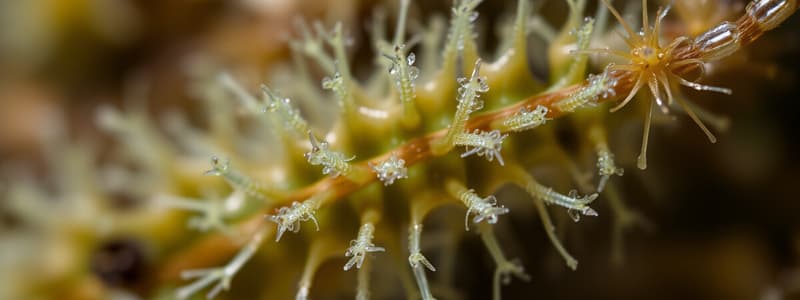Podcast
Questions and Answers
What theory suggests that disease was caused by vapors or poisons in the air?
What theory suggests that disease was caused by vapors or poisons in the air?
- Contagion Theory
- Germ Theory
- Miasma Theory (correct)
- Biogenesis Theory
Contagion Theory was proposed by Francesco Redi.
Contagion Theory was proposed by Francesco Redi.
False (B)
Who is credited with the development of antiseptic surgery?
Who is credited with the development of antiseptic surgery?
Joseph Lister
Living cells come from other living cells is known as __________.
Living cells come from other living cells is known as __________.
Match the following scientists with their contributions:
Match the following scientists with their contributions:
What did John Needham's experiment conclude regarding spontaneous generation?
What did John Needham's experiment conclude regarding spontaneous generation?
Tyndall’s experiments demonstrated that dust does not carry microorganisms.
Tyndall’s experiments demonstrated that dust does not carry microorganisms.
What did Agostini Bassi demonstrate about silkworms?
What did Agostini Bassi demonstrate about silkworms?
__________ established the relationship between Bacillus anthracis and anthrax.
__________ established the relationship between Bacillus anthracis and anthrax.
What did Pasteur use in his experiments to prove that microorganisms could not grow in sterile conditions?
What did Pasteur use in his experiments to prove that microorganisms could not grow in sterile conditions?
Which group of microorganisms are known for lacking peptidoglycan in their cell walls?
Which group of microorganisms are known for lacking peptidoglycan in their cell walls?
All microorganisms are pathogenic.
All microorganisms are pathogenic.
What process do cyanobacteria carry out that produces oxygen?
What process do cyanobacteria carry out that produces oxygen?
Antony van Leeuwenhoek is known as the first person to accurately observe and describe ______.
Antony van Leeuwenhoek is known as the first person to accurately observe and describe ______.
Match the following types of microorganisms with their characteristics:
Match the following types of microorganisms with their characteristics:
Which of the following is NOT a component of the five kingdom scheme?
Which of the following is NOT a component of the five kingdom scheme?
Eukaryotic microorganisms are simpler in structure compared to prokaryotic microorganisms.
Eukaryotic microorganisms are simpler in structure compared to prokaryotic microorganisms.
What is the major difference between prokaryotic and eukaryotic cells?
What is the major difference between prokaryotic and eukaryotic cells?
The primary role of microorganisms in the ecosystem is ______ recycling.
The primary role of microorganisms in the ecosystem is ______ recycling.
Which type of microorganism is categorized as acellular?
Which type of microorganism is categorized as acellular?
Flashcards are hidden until you start studying
Study Notes
Microorganisms Overview
- Most populous group of organisms, found globally.
- Essential for recycling nutrients, contributing to ecosystem balance.
- Source of food, beverages, antibiotics, and vitamins; aid in immune protection.
- Conduct photosynthesis; some cause diseases.
Microorganism Classification
- Studied due to their small size, often invisible to the naked eye.
- Divided into prokaryotic and eukaryotic categories.
- Prokaryotic:
- Bacteria: Commonly known as bugs, with peptidoglycan in cell walls.
- Archaea: Similar in appearance to bacteria but lack peptidoglycan and often found in extreme environments.
- Eukaryotic:
- Fungi: Can be single-celled or filamentous.
- Protista: Includes algae and protozoa.
Five Kingdom and Three Domain Systems
- Five Kingdoms: Monera, Protista, Fungi, Animalia, Plantae; microbes mainly in the first three.
- Three Domains: Bacteria, Archaea, Eukarya, based on ribosomal RNA comparisons.
Viruses
- Acellular and the smallest type of microbe.
- Do not fit neatly into the three-domain system; can cause diseases, including some cancers.
Historical Contributions to Microbiology
- Antony van Leeuwenhoek: First to observe microorganisms accurately.
- Robert Hooke: Contributed to the development of cell theory.
- Transition from Miasma Theory (disease from air pollutants) to Contagion Theory (disease from contact).
- Spontaneous Generation vs. Biogenesis:
- Aristotle proposed spontaneous generation; later disproven by experiments, notably by Francesco Redi.
Key Experiments
- John Needham: Claimed spontaneous generation after observing broth turbidity.
- Lazzaro Spallanzani: Improved Needham’s experiment showing no growth in sealed flasks.
- Louis Pasteur: Refuted spontaneous generation through flasks with curved necks; linked microbes to fermentation and germ theory.
Germ Theory and Disease Etiology
- John Tyndall: Demonstrated that dust carries microorganisms and developed methods to maintain sterile conditions.
- Agostini Bassi: Identified that a silkworm disease was fungal, first account of parasite theory.
- Joseph Lister: Introduced antiseptic surgical methods, reducing surgical infections.
- Robert Koch: Established Koch’s postulates linking specific microorganisms to specific diseases, shaping microbiological study.
Impact of Microorganisms on Health
- Enhanced understanding of host defenses and microbial metabolism, leading to better infection control.
- Emerged techniques for studying microbes refined over time, paving the way for modern immunology.
Studying That Suits You
Use AI to generate personalized quizzes and flashcards to suit your learning preferences.




